Feynman Path Integrals in Quantum Mechanics
Feynman Path Integrals in Quantum Mechanics
Feynman Path Integrals in Quantum Mechanics
- No tags were found...
Create successful ePaper yourself
Turn your PDF publications into a flip-book with our unique Google optimized e-Paper software.
K 0 is just the free-particle kernel (11). If we <strong>in</strong>terchange the order of <strong>in</strong>tegration over xand x(t) we get for K 1 :∫ t2K 1 (2, 1) = − ī F (s)ds , where (23)h t 1∫ 2[ ( ∫ īt2mẋ 2 )]F (s) = exp1 h t 12 dt V [x(s), s] Dx(t) (24)This expression F (s) can be <strong>in</strong>terpreted as free propagation from t 1 until some <strong>in</strong>termediatetime s and aga<strong>in</strong> from s until t 2 , only weight<strong>in</strong>g each path with a characteristic factorV [x(s), s]. Consequentely we can write F (s) <strong>in</strong> the formF (s) =∫ ∞−∞and with (23) the pertubation term givesK 1 (2, 1) = − ī h∫ t2∫ ∞t 1K 0 (x 2 , t 2 ; x s , s)V (x s , s)K 0 (x s , s; x 1 , t 1 )dx s (25)−∞K 0 (x 2 , t 2 ; x s , s)V (x s , s)K 0 (x s , s; x 1 , t 1 )dx s ds (26)The <strong>in</strong>terpretation is the follow<strong>in</strong>g: K 0 (2, 1) gives us the amplitude that the particle ismov<strong>in</strong>g all the way from 1 to 2 without be<strong>in</strong>g affected by V (x, t) at all. K 1 (2, 1) is theamplitude that the particle is scattered once at any time s between 1 and 2. K 2 (2, 1)will then be the amplitude to be scattered twice, and so on. This can be developed bysimilar steps as above. A very <strong>in</strong>terest<strong>in</strong>g feature of the kernel K V (2, 1) is that it fulfillsthe follow<strong>in</strong>g <strong>in</strong>tegral equation:K V (2, 1) = K 0 (2, 1) − ī h∫ t2∫ ∞t 1−∞K 0 (x 2 , t 2 ; x s , s)V (x s , s)K V (x s , s; x 1 , t 1 )dx s ds (27)We will not further look at that. It shall just be said, that this has some applications <strong>in</strong>scatter<strong>in</strong>g theory.5 <strong>Path</strong> <strong>Integrals</strong> <strong>in</strong> Phase SpaceAs we have seen <strong>in</strong> the end of 3.2, an equivalent def<strong>in</strong>ition for the kernel is K(2, 1) =〈x 2 |Û(t)|x 1〉. With this def<strong>in</strong>ition and mak<strong>in</strong>g use of Eq. (8) (Divid<strong>in</strong>g (t 1 − t 2 ) <strong>in</strong> N<strong>in</strong>tervals of length ɛ; we then assume Ĥ to be time <strong>in</strong>dependent on such an <strong>in</strong>terval, i.e.K(i, i + 1) = 〈x i |e −iĤɛ/¯h |x i+1 〉) one f<strong>in</strong>ds the follow<strong>in</strong>g expression for K(2, 1) [see [7]]:∫ N−1 ∏∫ N−1)∏ dp jK(2, 1) = lim dx i(ɛɛ→0 2π¯h exp ī N−1∑(p k ẋ k − H(p k , ¯x k )) , (28)hi=1 j=0k=0where ẋ k = 1 ɛ (x k+1 − x k ) and ¯x k = 1 2 (x k + x k+1 ). Similar to (6) we write that asK(b, a) =∫ ba[ īexph∫ tbt a](pẋ − H(p, x))dtDx(t) Dp(t)2π¯h(29)and call it the phase space path <strong>in</strong>tegral.The phase space path <strong>in</strong>tegral is somehow more general than the <strong>Feynman</strong> path <strong>in</strong>tegral.For the case where the Hamiltonian has its standard form (H = p 2 /2m + V (x, t))it is easy to show the equivalence to the configuration space path <strong>in</strong>tegral. One <strong>in</strong>serts 11the standard form of the Hamiltonian <strong>in</strong> (28) (the proper def<strong>in</strong>ition of (29)) and gets (5)by straightforward calculation, which then can be written <strong>in</strong> the form of (6).11 For the explicit calculations look aga<strong>in</strong> <strong>in</strong> [7].6



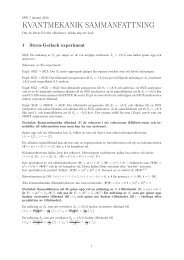

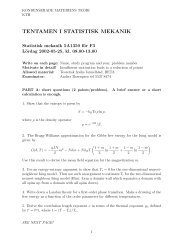
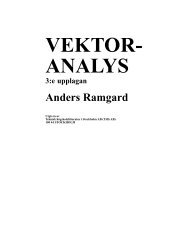
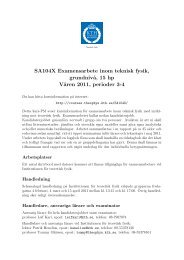

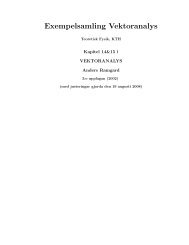

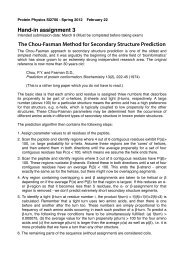

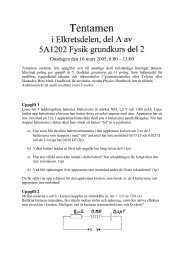
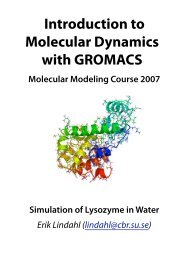
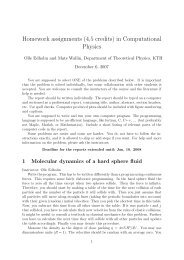
![[VAR]=Notes on variational calculus](https://img.yumpu.com/35639168/1/190x245/varnotes-on-variational-calculus.jpg?quality=85)